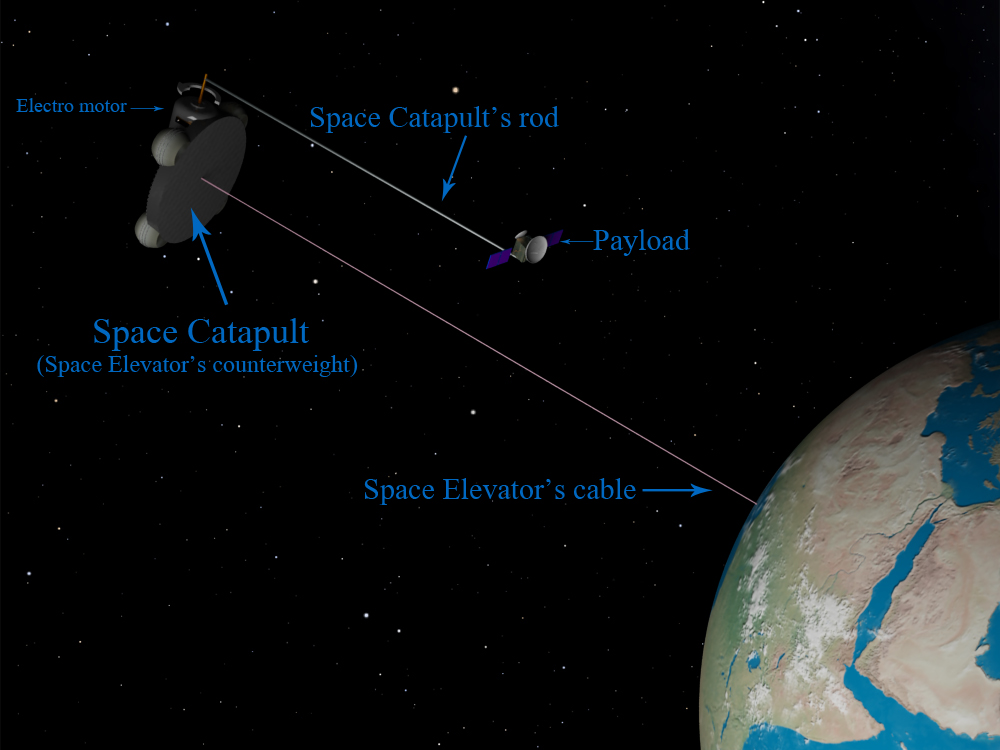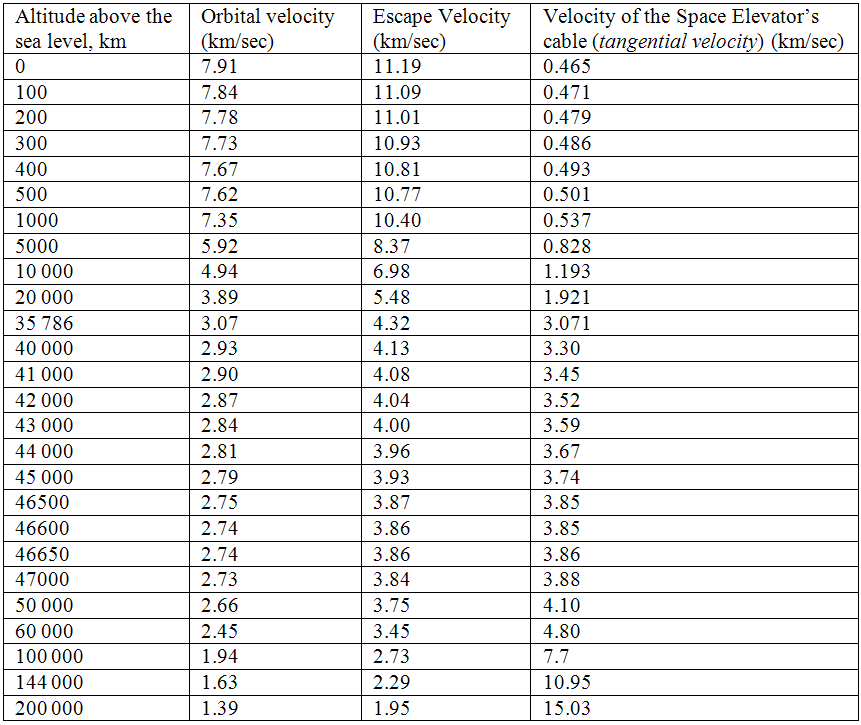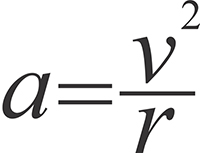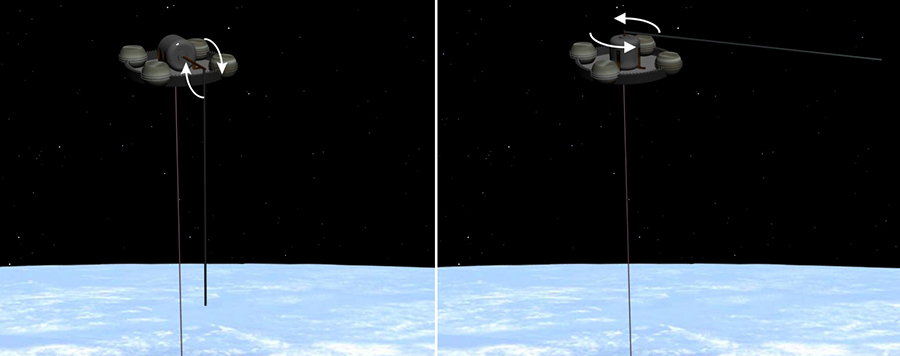OpenSpace 5
| Title: Place Title Here | ||
|
[Cover Img] |
About:
|
Tags:
|
Space Catapult
Author: Mr. Giorgi Lobzhanidze
Address: Tbilisi, Republic of Georgia, Europe
Email: mailto:giorgi9@gmail.com
INTRODUCTION
The new method for sending the spacecrafts in deep space is presented here. The paper describes the long rod rotated by electro motor placed at the Space Elevator’s counterweight and at Lagrangian points. This simple structure will enable the rod to gain high velocity and carry the payload with it. After reaching the desired speed the rod will release the payload that will fly in space along the imaginary circle’s tangent. This structure we called Space Catapult and it should work with the assist of Space Elevator. This latter should be used for carrying the payload from the Earth to Space Catapult’s rod.
For exploring the outer space the humankind generally uses the rocket engines, mostly chemical-propelled ones. They enable us the explore near-Earth celestial bodies and other planets in the solar system. They even enabled us to send several deep space missions beyond the solar system such as Pioneer-10, Pioneer-11, Voyager-1, Voyager-2, however by means of this technology the flight lasts undesirably long and it seems to be impossible to reach remote celestial bodies in space such as stars, so new technologies are necessary for this purpose. However new technologies do not necessary imply new kind of rocket engines, such as Ion Drives because they are capable for gaining several ten times higher speeds only, but for remote celestial bodies even they are not suitable. Besides, they need a huge amount of energy to be stored onboard the spacecraft and this will make additional problems. So, high speed should be achieved with absolutely different approach. How this can be done?
High speed can be easily achieved by means of fast-rotating rod around the electric motor. The motor’s rotational speed can be very high; the rod also can be quite long, hence the rod’s end’s linear speed can be extremely high, absolutely unachievable for any other technologies nowadays. The payload should be fastened at the rod’s end where the linear speed generally reaches maximal value. After reaching the necessary speed the rod will release the payload that will fly along the tangent from the current position. Thus the electric energy can be turned into payload’s speed and its velocity could be as high as we wish (except the speed of light of course). In principle the Space Catapult (thus we call this structure) would be the simplest, the most convenient and direct way for converting the energy/electricity into speed and conveying it to payload.
As we see the Space Catapult is quite uncomplicated structure, however if we wish to gain high speeds we should deploy it in space, not on the Earth. Indeed, our planet is surrounded with dense atmosphere that impedes any quick motion, so if we rotate the rod quickly the atmospheric drag and generated heat would burn it very soon, therefore the Space Catapult should be built and deployed in space only, and as we suppose-at the Space Elevator’s counterweight. In other words, the Space Elevator’s counterweight will operate as Space Catapult. See image below:
 Generally, what is the Space Elevator 1 2? According to modern concepts it will be the tall vertical structure built on equator and will have height of several ten thousand kilometers with its thin cable fastened to the base station on the Earth and with counterweight placed higher geostationary orbit. Because of balance between centrifugal force and gravity this structure will be stretched and the cabin will move along its cable carrying the goods into high orbit. After delivering the payload, the cabin will descend and carry the next one.
In Space Elevator’s concepts several solutions have been proposed to act as a counterweight:
Generally, what is the Space Elevator 1 2? According to modern concepts it will be the tall vertical structure built on equator and will have height of several ten thousand kilometers with its thin cable fastened to the base station on the Earth and with counterweight placed higher geostationary orbit. Because of balance between centrifugal force and gravity this structure will be stretched and the cabin will move along its cable carrying the goods into high orbit. After delivering the payload, the cabin will descend and carry the next one.
In Space Elevator’s concepts several solutions have been proposed to act as a counterweight:
1. Heavy, captured asteroid
2. Space dock, space station or spaceport positioned past geostationary orbit
3. Extension of the cable itself far beyond geostationary orbit.
The third idea has gained more support in recent years due to the relative simplicity of the task and the fact that a payload that went to the end of the counterweight-cable would acquire considerable velocity relative to the Earth, allowing it to be launched into interplanetary space. However this idea cannot be completely shared by us due to following reason:
It is well-known that the values of both Orbital and Escape Velocities decreases with increasing the altitude while the tangential velocity of Space Elevator’s cable increases. We can see the differences between them from the chart presented below:

As we see from this chart the tangential velocity of the Space Elevator even at its end (144 000 or 200 000 km altitude) is not very high to decrease the necessary time for covering the distance from the Earth to remote celestial bodies significantly. To achieve this, even the longer Space Elevator would be needed (its tangential velocity is directly proportional to its length) and this circumstance would complicate the technical task for building such Space Elevator. Because of this, there is no necessity to extend the cable itself far beyond geostationary orbit as proposed in the third variant. In any case, we have already seen that by means of Space Catapult it is possible to gain such huge velocities that are absolutely unachievable with other technologies, for example with Space Elevator. Therefore, using the counterweight and placing the Space Catapult there definitely has got some technical sense.
However, we think that the question where the Space Catapult should be placed needs further discussion. Theoretically, the Space Catapult with its payload and nuclear reactor/solar panel needed for rotating the rod may be mounted not only at the counterweight, but on the Space Elevator’s cabin also that can carry all these goods to space in a usual way, as it should do it according to Space Elevator’s modern concepts. This option is quite possible, however for realizing this we need to know the mass of the payload, nuclear reactor/solar panels’ mass plus Space Catapult’s mass from one hand and Space Elevator’s lifting capacity (this must be more) from other hand, but these data are not available nowadays, therefore we think that the Space Catapult should be still mounted at the Space Elevator’s counterweight where it will be possible to send the payloads into deep space in continuous mode at high velocities.
As we saw the Space Catapult is capable to gain very high velocities; however there is being developed other technologies and they in future will enable the spacecraft to fly at high speeds in space. These are Ion Drive systems, more precisely the most perspective one-Variable Specific Impulse Magnetoplasma Rocket (VASIMR) which still under development can be used in future for deep space missions. Can these engines and Space Catapult be the rivals in space? Since none of them have been built and used in space yet we cannot give a persuasive answer to this question; however still it is possible to underline Space Catapult’s one significant advantage: if the future spacecraft uses the VASIMR (or any other kind of Ion Drive) engine it will definitely need to be equipped with nuclear reactor, otherwise the spacecraft will not be able to gain high speeds, also it will need to carry fuel tanks for this purpose. As for the Space Catapult, it can give much higher speed to spacecraft, besides it will have stationery power plant (see Energy source placed on the Space Elevator’s counterweight) at the Space Elevator’s counterweight, so the payload will not have to carry the nuclear reactor onboard and this circumstance will lighten the work for deep space spacecraft. Besides, we should not forget that unlike the spacecrafts equipped with ion drive engines the Space Catapult will need no fuel for gaining high velocities.
Briefly, Space Catapult’s advantages over any kind of propulsion systems are:
1. Ability to gain any speed that is absolutely unachievable by means of other kinds of engines.
2. No need by spacecraft to carry energy source that would make it too heavy and impracticable.
The Space Catapult needs long rod
When building the Space Catapult at Space Elevator’s counterweight we should install quite long rod there, the shorter the rod is, the easier would be installing it, however we should note that rod cannot be extremely short, let’s say 1 km length or so due to following reason:
When we are going to send some payload into space, we need not only high velocity, but one certain direction also. The little inaccuracy in direction, inclination in several arcminutes is actually acceptable since the spacecraft would easily balance it with its engines; however great inclination from the initial direction would send the spacecraft into the completely different direction and in such case the whole mission will fail.
If two Space Catapult’s rods have the length of let’s say 1 kilometer and 10 kilometers, then for giving to payload some certain linear speed (for instance 100 km/sec) these rods should rotate at different angular velocity. It is easy to ascertain that the shorter rod should rotate 10 times faster to gain the same linear speed than the rod with more length. But the faster the rod rotates, the more difficult will be to “catch” the needed moment for releasing the payload from the rod for sending it towards some certain direction. If the rod is too short, then it has to rotate very quickly for gaining some certain linear speed and therefore it will be extremely difficult catching the needed moment for releasing the payload. Hence, too short rod can make problem for sending the payload to some certain direction in space especially at high velocities. So, based on payload’s needed velocity we should find rod’s desired, minimal length that will enable us to send the payload in space to necessary direction without fear that it may yaw from the course.
However, rod’s length will be crucial for payload’s abilities for withstanding the acceleration also. As an example, we can try to calculate its value which the payload will have to withstand during rod’s rotation. The acceleration of the body rotating at the circle with some constant velocity is calculated by the following formula:
Where a is acceleration in m/sec2, v is payload’s linear velocity on the circle in m/sec and r is radius of the circle in meters, in our case it is equal to rod’s length. Let’s assume that the rod is 100 km length and the electromotor rotates it so that payload’s speed is equal to 50 km/sec, in this case acceleration will be equal to 25 000 m/sec2, which is about 2550 g. The modern technologies enable to design and manufacture the spacecraft’s subsystems (avionic and etc.) capable to withstand such acceleration. This circumstance somehow restricts the speeds that we can achieve, in any case their values actually depends on spacecrafts’ abilities for withstanding g-loads. But what can we do if much higher speeds are needed? The answer directly derives from that formula: the radius should be more; by the way note that this is additional reason why the longer rod is more useful. If we are able to make the extra long rod, then this will enable us to gain much higher velocities.
What material should be used for manufacturing the rod? It is obvious that if very high speeds are needed the rod should be long and even in this case the acceleration at its end will be quite high, therefore sufficiently strong and light materials are needed for this purpose and making them is as similar challenge as in case of Space Elevator where the same requirements arises for the cable’s material. The lightness is needed because in case of heavy rod a lot of energy will be needed to rotate it; the strength is needed because in case of lack this property the rod will be destroyed due to great acceleration.
The mechanism for holding and releasing the payload
How the payload can be held by Space Catapult’s rod during rotation and how it can be released from the rod? We think that using electromagnet plus mechanical holding devices would be a good solution. More precisely, after the payload is attached to the rod it must be held by means of both methods until the rod accelerates and reaches necessary velocity (it may take even several days), but with approaching the desired speed the mechanical device should release the payload however the electromagnet(s) should still hold it. The explanation of such approach is following: generally the mechanical devices are much slower/sluggish in performance than electronic ones. We have already said that when releasing the payload the extreme accuracy is needed and mechanical devices cannot guarantee the exact time of releasing the payload unlike electronic ones. That is, it’s unlikely that mechanical devices can release the payload at some certain moment when needed while in case of electromagnet it would be enough to cease electric current there, it would lead to immediate vanishing of the magnetic field and sending the payload along the tangent from the point where the payload would be at the current moment.
We think that the fastest control system would enable to release the payload to certain direction. This system (extremely fast-operating computer plus measuring equipments) should know the current position of the rod’s end, the current speed, the needed direction and be capable for computing the necessary moment for giving the order for diminishing the voltage for electromagnets and hence releasing the payload to desired direction and velocity.
Rod’s plane of rotation towards the Earth
The Space Catapult’s rod when rotating makes the circular plane/flatness in space and this plane may be horizontal/parallel to Earth surface, that is making the right angle to Space Elevator’s cable or it may be placed along the cable; see the both possible situations here:
Both approaches have got their advantages/disadvantages and here we will discuss this question, first of all from the point of view of safety.
For gaining extremely high velocities quite long rod would be needed, maybe with the length of several thousand kilometers or even more. If such rod is placed along the Space Elevator’s cable then the rod during rotation will cross many orbits from the Medium Earth Orbit to High ones. When rotating, the rod may actually hit any satellite and/or space debris object and such collision can lead to rod’s complete destruction; therefore we should choose such plane which would be much more free from any artificial objects; hence if the rod rotates horizontally/parallel to Earth’s surface at high enough altitude where the satellites’ population is relatively low then this measurement would justify itself because under such circumstance the rod will not cross satellites’ orbits (rod’s plane of rotation will simply coincide to one orbit’s path). However, we should also note that this altitude actually depends on the Space Elevator’s proposed length. Indeed, the Space Catapult’s rod should be mounted at the Space Elevator’s counterweight; this counterweight from its side should be placed at the end of the Space Elevator at such altitude where the satellites’ population is as low as possible. This means that Space Elevator’s proposed height should be agreed with mounting Space Catapult on its counterweight. According to various databases the number of man-made objects at high orbits, more precisely beyond geostationary orbit is much less than on the lower orbits 3 4 5 6, therefore the Space Catapult with its rod should be located at the altitude of 50 000-60 000 km above the sea level. At such altitude the space is almost free and nothing will impede rod’s rapid rotation. Besides, the satellites at high orbits are orbiting around the Earth slower than on the lower orbits (as known any satellite orbits around its primary body slower in apogee than in perigee), therefore if some tracking system is mounted at Space Elevator’s counterweight then it will enable the Space Catapult to avoid undesired collision with satellites during Space Catapult’s performance. In other words, the Space Catapult should operate only when the there are no satellites near its vicinities.

